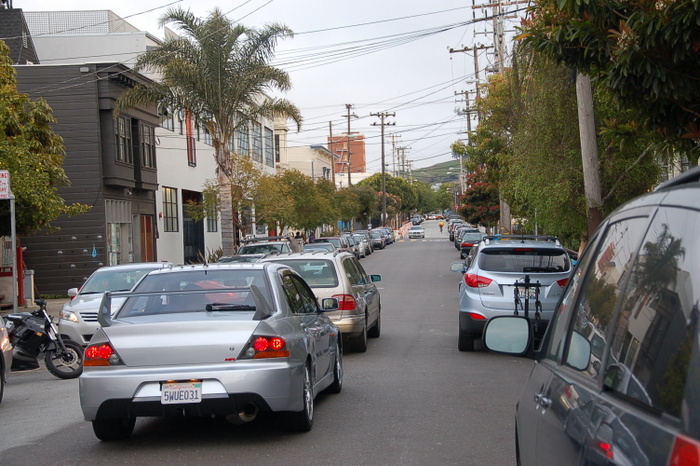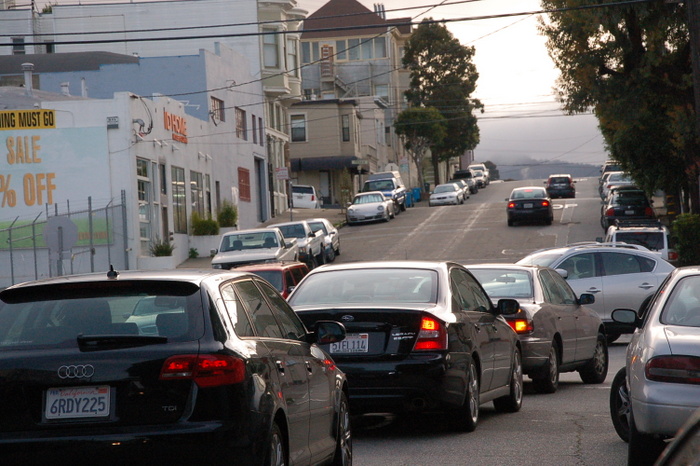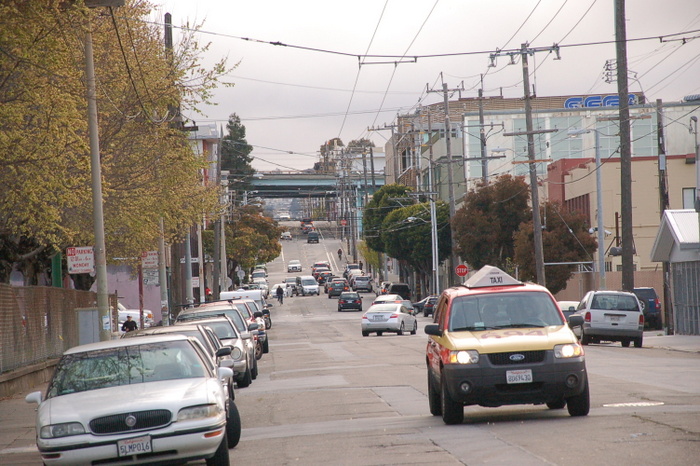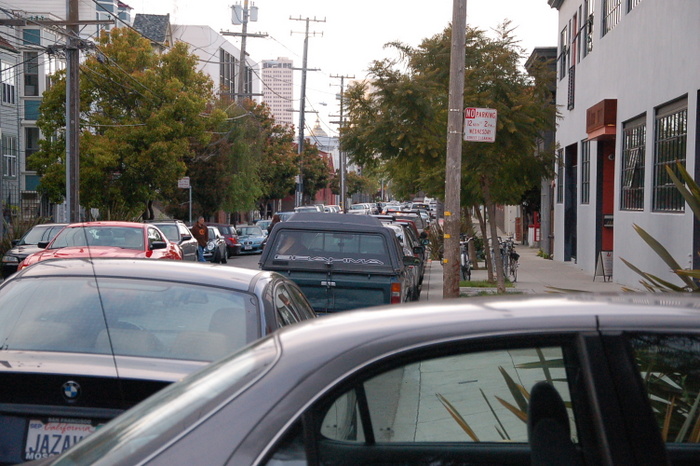Aiming to Win Over Critics, SFMTA Spells Out Its Parking Policies on Paper
5:10 PM PDT on August 10, 2012

The SF Municipal Transportation Agency's embattled efforts to put a rational price on the city's car parking supply by expanding parking meters have led the agency to develop a document [PDF] that, for the first time, lays out its parking policies in one place. SFMTA officials, who presented a draft to the SFMTA Board's Policy and Governance Committee today, say the document is intended to clarify the agency's goals and make its parking management decisions more transparent.
As Streetsblog has written, when parking is free or underpriced, spaces fill up, and drivers cruise around for a spot. That means more pollution, traffic congestion, gas consumption, wear on the roads, slower transit, more danger for people walking and biking, and fewer driving customers able to park near businesses.
The SFMTA's plans to install parking meters in the Dogpatch, Potrero Hill, and northeast Mission neighborhoods ran into heavy opposition in January from the Eastern Neighborhoods United Front (ENUF), which was formed in opposition to the parking plan. Among the group's wide-ranging complaints, it says the SFMTA performed poor outreach, and that some of the proposed locations for meters aren't appropriate. The SFMTA delayed its metering plans to do more analysis and outreach and plans to hold community meetings later this year.
But whether ENUF's members just don't want to pay for parking (which they deny), or the group's complaints are legitimate, one thing is clear: many members say they distrust the SFMTA when the agency says its goal is to properly manage its parking supply. Rather, it seems to many car-owning members, the SFMTA is simply after their money (even if the cost of free parking is externalized to the general public, and the meter expansion plans are supported by advocates like Livable City who don't receive revenue from them). Mari Eliza, an organizer with ENUF, told the SF Chronicle this week that "people are really ready to fight back" against parking meter expansions. "The city is just going too far," she said.
"Meters are appearing all over San Francisco," ENUF's website says. "Next, the meters will be on your street in front of your home."
In response to the insistent opposition to SFPark, the SFMTA's promising pilot program to test out demand-responsive meters which accept credit cards (and can even have lower rates than conventional meters), the agency removed SFPark from the meter expansion in those neighborhoods. By adjusting prices according to demand, SFPark's goal is to generally keep one space open on every block. Instead, the SFMTA is developing a plan which will only include conventional parking meters.
While the new document doesn't actually change any policies or practices, SFPark manager Jay Primus called it "a really positive step forward."
"This mundane document, like the parking census, is actually very exciting," said Primus. "This helps the MTA communicate how, where, and why it uses different parking management strategies, it increases the transparency of its parking management decisions, and it explains how those decisions are consistent with the MTA's goals."
To create the "effective, efficient, and safe transportation system" called for in the City Charter, the document says the SFMTA's policy is to manage parking in pursuit of four goals:
- Improve safety for all road users. Reduce circling and double-parking, lessening hazards for pedestrians, bicyclists, and other drivers presented by distracted drivers looking for parking.
- Improve Muni’s speed and reliability. Reduce circling and double-parking, helping Muni and other transit operators operate more reliably and safely, especially on busy commercial corridors.
- Improve neighborhood quality of life. Manage parking to improve access, reduce congestion and greenhouse gas emissions, and enhance quality of life in San Francisco’s diverse neighborhoods.
- Increase economic vitality and competitiveness. Improve access to commercial areas whether by car, foot, bicycle, or transit. This facilitates deliveries, commerce, and overall economic activity for San Francisco’s businesses.
The document also lists a number of principles which it follows in managing parking. Here are a few (check out pg. 4 of the document [PDF] for more):
- Limited right of way should be well-used. Maintaining a minimum level of parking availability is critical for delivering the SFMTA’s goals for parking and transportation and is a core measure of parking management success. When a minimum level of availability is achieved, it is easier to find a parking space, drivers double park and circle less, access to businesses, and public safety are improved, as is transit performance.
- Maintaining a minimum level of availability creates a desirable level of turnover. Parking turnover is a consequence of maintaining parking availability. On blocks with low parking demand, availability can be maintained with little turnover. Conversely, blocks with high parking demand require more turnover in order to maintain a minimum level of availability. Thus, the desirable amount of turnover can vary block to block and will result from achieving a minimum level of parking availability.
- Parking policies are designed to encourage travel by public transit and sustainable modes of transportation. The SFMTA manages parking to prioritize public transit, walking, bicycling, and the needs of paratransit and commercial deliveries. City policy notes that “parking policies for areas well served by public transit shall be designed to encourage travel by public transit and alternative transportation” and that “decisions regarding the use of limited public street and sidewalk space shall encourage the use of public rights of way by pedestrians, bicyclists, and public transit, and shall strive to reduce traffic and improve public health and safety."
The document lays out a range of guidelines for where to use meters, residential parking permits (RPPs), time limits, and color curb regulations. Lauren Mattern, manager of the SFMTA's eastern neighborhood parking management plans, said the document would set clear policies for which of those to use on blocks with mixed-use buildings like "live-work" lofts, where the differentiation between residence and businesses can be a grey area -- one of the major issues of contention with ENUF.
Whether the document will help appease ENUF is unclear. In discussions with Streetsblog in April, Tony Kelly of the Potrero Hill Boosters Association insisted that he and members of ENUF agree with the need for parking management, but take issue with adding meters to some mixed-use blocks where they didn't think the demand was high enough. However, ENUF spokesperson John Lum said he didn't see how meters increase turnover, and that "making one neighborhood more expensive to park in for the people who live and work here, for no added benefit, is tacitly unfair." (Lum also opposed bike lanes on 17th Street that removed some parking spaces.)
ENUF's website says it is conducting its own survey of parking demand in the neighborhood which it expects "will result in a more tailored parking plan that meets the real needs of our neighborhoods rather than the one-size-fits-all plan to blanket the areas with parking meters."
On ENUF's email list, members discussing the document questioned the SFMTA's motives. "The usual MO of MTA has been to print appeasing public policy, and then to aggressively do whatever they want to do without listening to anybody else," one member wrote.
Some also seemed to think the document would change the RPP program, which gives permit-holding residents priority for free curbside parking by imposing time limits (the document only describes the system that's been in place for decades). Although ENUF has called for the creation of RPP zones in place of meters (they're initiated by petition), Primus said the program has been ineffective in creating parking turnover and encouraging residents to use other transport modes. Enforcing RPP is also a drain on the SFMTA's parking enforcement staff, who must make multiple rounds and mark tires with chalk to gauge how long a car is parked. SFMTA staff said it is reviewing the RPP program and may add changes to it in the policy document next year, along with more specific policies on the use of time limits.
Primus said the document was emailed to distribution lists this week, has been presented to the SFMTA Citizens Advisory Committee, and is still under review by city agencies before it's set to go up for approval by the SFMTA Board of Directors on September 18.
Stay in touch
Sign up for our free newsletter
More from Streetsblog San Francisco
Streetsblog SF editor Roger Rudick offers constructive criticism of Chicago’s downtown bike network
"There were blocks that felt very safe and very secure," he said. "But then you're immediately – voom! – disgorged into three lanes of moving traffic with no protection."
Commentary: There is Zero Ambiguity to the West Portal Tragedy
What happened in West Portal was entirely predictable and preventable. The city must now close Ulloa to through traffic and make sure it can never happen again







